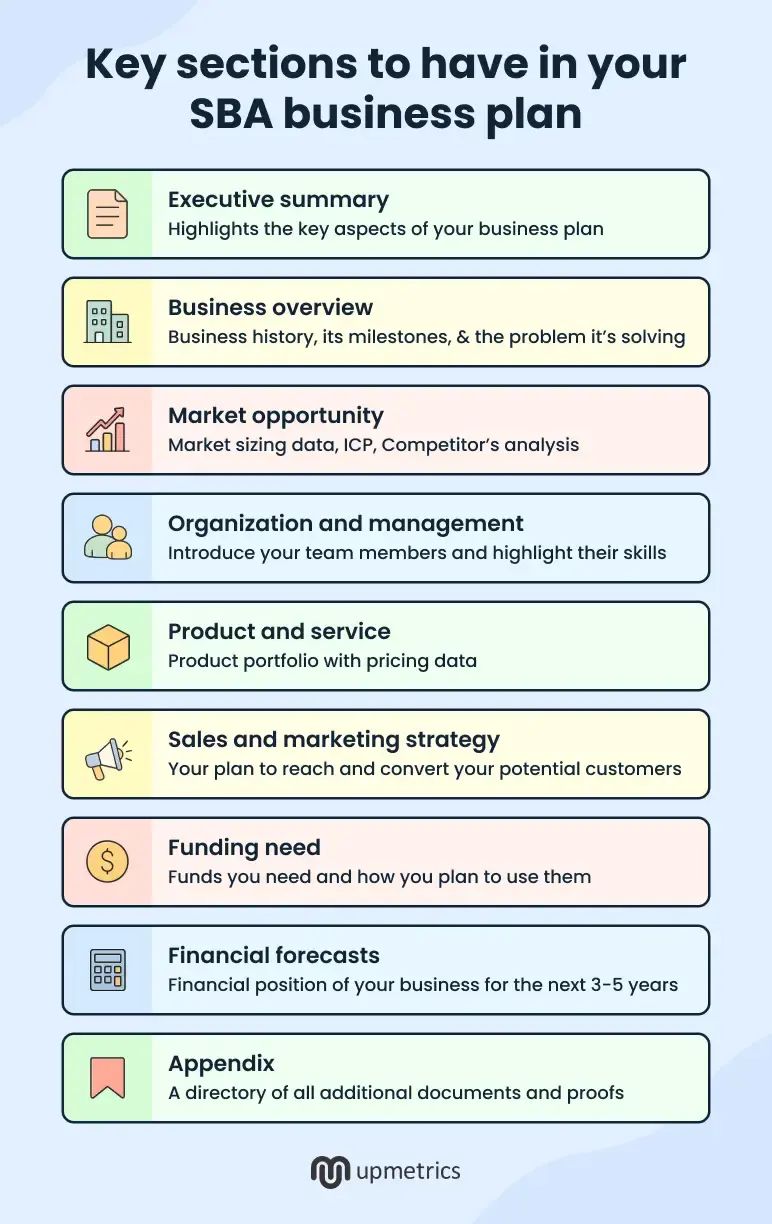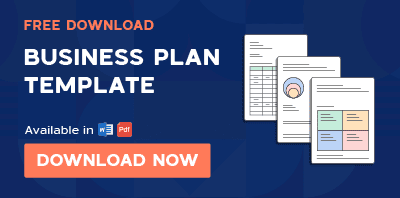In 2024, nearly 51% of SBA loan applications were fully approved and 34% partially approved.
That’s a solid approval rate, proving that SBA loans are accessible, even with all the paperwork involved.
I review hundreds of applications at Midwest Regional Bank every year. And if there’s one major reason for rejection, especially amongst applicants who met the eligibility criteria, it’s their business plan.
Lenders don’t want you to write a hundred pages of a thick booklet explaining every minor detail. But there are specific details we lenders need upfront to ensure your business is a strong candidate for SBA loans.
Read along, and I will share how lenders evaluate your SBA business plan and what you should include in yours.
How is the SBA business plan any different from traditional plans?
Generally, a traditional business plan is a document that offers a detailed overview of your business, tailored to whoever is reading it.
It can be investor-focused (demonstrating scalability and aggressive growth), management-focused (outlining business processes and operations), or a growth-focused document (outlining your long-term strategies and tactics).
Your SBA business plan also falls under the umbrella of a traditional business plan, but it’s purpose-built for lenders (SBA lenders to be precise).
It’s designed to meet the formal requirements of your SBA loan application. And lenders use it to assess three things:
- Can your business repay the loan?
- Can it maintain consistent revenue?
- And will the funds be used for activities the program permits?
Simply put, what separates an SBA plan from any other plan is the purpose and audience consuming it.
What should you include in your business plan for an SBA loan (SBA lender insights)
I review dozens of so-called “SBA-compliant” plans every month at Midwest Regional Bank, and do you know what’s the major reason for rejecting most of them?
Weak structure and incomplete information. I’m not saying it’s the only reason, but definitely a major one.
And this isn’t just my opinion. I’ve talked to my colleagues, and they all see the same issue. Applicants submit 40-page documents, but when we dig in, those plans don’t answer our most critical questions. Or worse, the information is buried so deep in generic business jargon that we can’t find it without wasting hours.
So here’s a lender-specific POV of what we expect to see in each section of your business plan and how you should present it. quickly.

This is just a format that I recommend. Feel free to adjust and tweak the outline in a way that serves your needs the best:
1. Executive summary
Offer a high-value overview of your entire business plan in this section.
Tell us what your business does and give us a reason to dig deeper. It’s said to keep your executive summary within 2 pages. I say, cut that down to 1 page, and only include details that are of utmost importance.
Here’s what I want to see in your executive summary :
- What your business does
- What’s the market opportunity
- How much funding do you need, and how will that money influence growth, i.e., show how the new equipment will boost production or revenue
Don’t clump the section with too many details. Identify what are the driving levers of your business and present them tactfully.
My advice: Only write this section when you are done writing your entire business plan. This way, you will have a complete understanding of what needs attention.
2. Company description us
This is where your business plan actually begins. So take this opportunity to introduce us to your core values, business achievements, and history.
Mention details about your business structure and terms of partnership. Clarify the profit and loss ratio and capital investment by each partner.
These details are important, especially to cross-verify ownership and personal guarantees we’ll need for the loan.
Further answer these 3 core questions:
- What’s the problem you’re addressing? This gives us an idea of whether you are chasing a valid problem
- What’s your solution? Align your offerings with the problems and show us how your solution is unique or superior to competitors.
- Is a product with new features in development? Detail that and share if you’ve procured any IPs, like trademarks or patents, for your solution.
3. Market analysis
Here, we analyze how well you understand your industry and if there’s a sizable opportunity for you to capture.
For that, we need a detailed description of your ideal customers, target market, competitors, and the trends in your industry.
Approach this section in 4 parts:
Industry overview and trends
Include a brief macro overview of your industry and narrow it down to your specific market. Show how your specific market is growing and the trends dominating it.
For instance, if you’re launching easy-to-prep meal kits, we want to see data on the meal kit industry’s growth rate. Then narrow it to your region and show demand for quick meal solutions among working professionals there.
Market sizing
Include market sizing figures, i.e., TAM, SAM, and SOM, and list down the assumptions or methodology you used to arrive at those numbers.
Lenders want to see if the market is big enough to support your revenue projections.
Ideal customer profile (ICP)
List down the different market segments you would be catering to and include a buyer’s persona for each. Highlight the demographic (age, income, location) and psychographic details (behavior, needs, wants, pain points) of your ideal customer so we can confirm if the market actually needs your solution.
For instance, our ideal customer is a 25-40-year working professional, with an income between $100K-$150K. This individual wants healthy, quick meals but has time constraints. They would happily splurge up to $50 on a meal-prep kit twice or thrice a week.
Competitors analysis
List down your direct and indirect competitors and show us how you would leverage their weaknesses or compete with them strongly.
4. Organization and management
Introduce the people who are running the show at your business. Managers, leaders, the chief operations officer, the finance head, and advisors. Talk about their profile, accomplishments, and experience.
Be braggy here. We want to see that you have the people and skills to execute the vision. Make us believe in your team.
Draw an organizational chart if you already have a team of 50 members or so. Even if not, just include a line that clarifies your hiring plans.
5. Service or product
Bring your product or service portfolio here. If it’s a portfolio of hundreds of products, better list down the categories and explain the value it provides to your customers.
If it’s a technical product, include an MVP or a beta product version for the lenders.
Here’s what you should include in this section:
- Pricing of your products and services (preferably a table)
- Production or outsourcing plan
- Warranties or guarantees you offer
- Products you plan to launch
Make this section visually rich with the right kind of visuals. Product photos, charts showing your pricing tiers, or diagrams of your production process work well.
For instance, if you’re a consultant, show hourly pricing for each of your services, or display your subscription tiers in a clear table.
6. Marketing and sales
Outline your plan to attract, acquire, and retain customers in your business. Show us that you understand where your customers spend their time and will consume your marketing efforts.
If you ran marketing campaigns earlier, include details about ROI and how your brand stands to benefit from targeted campaigns.
You should also clarify your distribution model. Will you sell through retail outlets, direct online sales, or third-party platforms?
Your sales process matters too. Walk us through how a customer goes from discovering your business to making a purchase. Is it a single transaction or a longer sales cycle with multiple touchpoints?
If you’re B2B, explain how you generate leads. If you’re B2C, show us your customer acquisition cost and how you plan to reduce it over time.
The idea is to make us believe that you can actually reach customers and convert them into paying buyers, with proof and traction.
7. Funding request
Make your funding request and offer a very detailed breakdown of how you will utilize that fund.
This is important for 2 reasons. We:
- Want to ensure that you will utilize the funds in eligible activities for that particular loan
- Need to see that you’ve thought through your costs realistically
Include quotes and estimates to help us evaluate your request. That is, if you are seeking a loan for an equipment purchase, attach a vendor quote. Similarly, if you’re renovating, show contractor bids.
If you are offering collateral or bringing in personal investment, add your collateral valuations here. And also, the term of the loan you expect to get.
8. Financial Projection
The financial section of your SBA business plan helps us assess whether your business can actually afford the loan. Lenders need some clear documents and specifics here, and most of these are non-negotiables.
Financial projections
How will your business finances look over the next 3-5 years? Will your revenue grow? What will be your major expenses? How will your profit margins evolve?
Lenders want to see conservative projections grounded in realistic assumptions. And also the explanation of those numbers.
Include monthly projections for the first year through income statement, balance sheet, and cash flow forecast—and annual forecasts for the years thereafter.
Repayment strategy
Show how your loan payments fit into your monthly cash flow for the entire loan term. For instance, if you’re requesting $250,000 with an estimated monthly payment of $4,500, that payment should be visible as a line item in your cash flow forecast every single month.
Also, if you have existing loans, account for those payments in your cash flow projections too. We want to see if your business can handle debt without defaulting or straining operations.
Historical financial statements
Include at least two years of historical financials—tax returns, profit and loss statements, and balance sheets. This gives us a baseline to evaluate whether your projections are realistic or inflated.
Key metrics and visuals
You can move your detailed financial statements to the appendix and keep this section visually rich using graphs and charts.
But make sure you present these metrics that will allow us to assess your financial health:
- Break-even point
- Gross profit margin
- Projected revenue growth
- Net present value
- Customer acquisition costs
- Net profit margin
- Debt service coverage ratio
9. Appendix
Include all the supporting documents, research, and financial statements in this section. This way, you can build a fairly lean plan without crimping on the details.
What lenders expect to see here:
- Licenses and Permits
- Partnership agreement
- Market research data (primary)
- Technical blueprints and documents supporting your product development
- Marketing materials
- Financial statements
- Resume of your team members
- Collateral documents
- Credit history
- Contracts
Don’t just add any documents. Everything you include here should be linked back (or add footnotes) to the specific information it supports in your plan.
That’s all the information we lenders expect to gather from your business plan. As you can see, it’s a lot, so structure your plan clearly and let the information flow cohesively.
Rebecca’s (SBA) business plan example
This SBA plan example, built around Rebecca Champ’s “We Can Do It Consulting”, is worth studying before you write your own business plan.
It’s just 8 pages long. But includes every detail we lenders need to evaluate a service-based business. What stands out is how clearly Rebecca explains her consulting services without drowning us in industry jargon.
The plan introduces her three-person team, breaks down her hourly pricing structure across different consultant roles, and explains exactly who her target customers are—business owners and executives with 5 to 500 employees. She even gets specific about which local industries she’ll target first: manufacturing, automotive, healthcare, and defense.
This is the level of clarity we expect from your plan.
If you find yourself questioning how much detail is too much detail, come back to this plan and take inspiration from it.
What I look for in a business plan as an SBA lender (Tips to improve your chances)
In one of the recent webinars with Upmetrics, I discussed a 5-point checklist that I always use to evaluate whether a business is a strong candidate for a loan. If you have these, ensure your plan reflects them through explanations and structure.
1. Fundable business model
You may be solving a real problem and might have a solid solution. But if you can’t make money, it all boils down to zero. I want to see how a business generates revenue, be it through product sales, subscriptions, service fees, or licensing.
Show me that there’s a scalable opportunity where your business can grow without a significant increase in costs.
2. Financials and a loan repayment plan
I want to see how your cash flow will change with an influx of loan money and how its monthly repayment will affect your cash situation. Give me projections for different aggressive and progressive situations so I can analyze the risks associated with your business.
I also need debt coverage ratios and your historical payment behavior on existing debts. I need to ensure that your finances are within our threshold limit.
3. Management experience
We need people who have had some experience managing a similar business or working in the same industry for several years. If you don’t have that, demonstrate the skills you’ve developed that translate directly to running this business.
Show us your team’s combined expertise. A strong operations manager or financial advisor on your team can offset gaps in your own experience.
4. Evidence of market demand
I look at your market sizing data to see if there exists a scalable market for your solution. I’m looking at your quarterly sales and revenue figures, pre-orders, average customer order value, and customer lifetime value to validate the market demand. Have these in your market opportunity and financials section.
5. Fund utilization plan
I need a clear understanding of where and how you will utilize the loan amount. Some loans are specifically designed for capital expenditure, while some (504 loans) can’t be used as working capital. I need to ensure your utility plan aligns with the loan you are applying for.
STREAM Academy, a non-profit educational institution, was struggling to put together a business plan for its SBA application. Upmetrics’ custom templates and collaborative workspace helped them develop a plan that secured them $500,000 in grants.
Free resources to write your (SBA) business plan
Despite having the fundamentals figured out, it can get difficult writing your loan business plan. You can try these free resources and templates from the SBA to make an easy start:
- MySBA Learning: Take SBA’s online courses designed to help you write a business plan, and also explore other courses to guide you in launching a successful startup
- SCORE templates: Along with its primary mentorship services, SCORE (SBA’s resource partner) offers free business plan templates to get a quick head start
- Industry-specific templates: Upmetrics offers 400+ business plan samples in the SBA-approved format. Choose a template that resonates with your industry and get built-in specific examples
- In-person sessions: Enrol for workshops hosted by the SBA as well as Small Business Development Centers (SBDC) to help you write a business plan
For in-depth planning and forecasting assistance, you can choose Upmetrics. The tool offers a lender-approved SBA business plan template filled with expert tips and detailed instructions.
With Upmetrics AI assistance, you can present your business ideas cohesively. And also build reliable forecasts without Spreadsheet chaos or complicated calculations.
Upmetrics’ SBA lending services can match you with the preferred SBA lender. You can save months on your application and get things right on the first go when you choose someone with such expertise to guide you.
I truly believe Upmetrics can be a solid pick for your SBA loan planning process.


